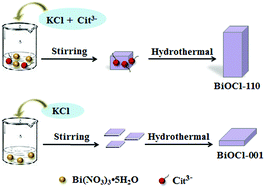当前位置:
X-MOL 学术
›
New J. Chem.
›
论文详情
Our official English website, www.x-mol.net, welcomes your
feedback! (Note: you will need to create a separate account there.)
Controllable synthesis and photoreduction performance towards Cr(vi) of BiOCl microrods with exposed (110) crystal facets†
New Journal of Chemistry ( IF 2.7 ) Pub Date : 2018-09-12 00:00:00 , DOI: 10.1039/c8nj03323d Yin Peng 1, 2, 3, 4 , Yan Ge Mao 1, 2, 3, 4 , Peng Fei Kan 1, 2, 3, 4 , Jin Yun Liu 1, 2, 3, 4 , Zhen Fang 1, 2, 3, 4
New Journal of Chemistry ( IF 2.7 ) Pub Date : 2018-09-12 00:00:00 , DOI: 10.1039/c8nj03323d Yin Peng 1, 2, 3, 4 , Yan Ge Mao 1, 2, 3, 4 , Peng Fei Kan 1, 2, 3, 4 , Jin Yun Liu 1, 2, 3, 4 , Zhen Fang 1, 2, 3, 4
Affiliation

|
Bismuth oxyhalides have been of great interest, since they induce a strong internal static electric field and promote the effective separation of photoinduced electron–hole pairs, which enables good photocatalytic performance. However, simple synthesis and easily controllable facet exposure remain great challenges in this regard. Here, BiOCl microrods were synthesized via a simple hydrothermal method, using sodium citrate as a capping agent. High-resolution transmission electron microscopy (HRTEM) images show that the BiOCl microrods have (110) facets (BiOCl-110) exposed and grow with a [1![[1 with combining macron]](https://www.rsc.org/images/entities/char_0031_0304.gif) 2] orientation. X-ray photoelectron spectroscopy (XPS) and FT-IR spectra show a number of citrate ions on the surface of BiOCl-110. An Ostwald ripening growth mechanism for BiOCl-110 has been demonstrated in our study. In addition, the photocatalytic performance of BiOCl-110 was evaluated via the degradation of hexavalent chromium (Cr(VI)) under solar light irradiation. From this, BiOCl-110 exhibits more excellent photoreduction performance towards Cr(VI) than BiOCl-001, and Cr(VI) at a concentration of 30 mg L−1 can be completely photoreduced within 4 and 10 min under acidic and neutral conditions, respectively. This enhanced photoreduction performance is ascribed to the more negative conductive band position of the (110) crystal facets, which enhances the reductive ability of photoelectrons.
2] orientation. X-ray photoelectron spectroscopy (XPS) and FT-IR spectra show a number of citrate ions on the surface of BiOCl-110. An Ostwald ripening growth mechanism for BiOCl-110 has been demonstrated in our study. In addition, the photocatalytic performance of BiOCl-110 was evaluated via the degradation of hexavalent chromium (Cr(VI)) under solar light irradiation. From this, BiOCl-110 exhibits more excellent photoreduction performance towards Cr(VI) than BiOCl-001, and Cr(VI) at a concentration of 30 mg L−1 can be completely photoreduced within 4 and 10 min under acidic and neutral conditions, respectively. This enhanced photoreduction performance is ascribed to the more negative conductive band position of the (110) crystal facets, which enhances the reductive ability of photoelectrons.
中文翻译:

具有暴露的(110)晶面的BiOCl微棒 对Cr(vi)的可控合成和光还原性能†
卤氧化铋受到了极大的关注,因为它们可以感应强内部静电场并促进光致电子-空穴对的有效分离,从而实现良好的光催化性能。然而,在这方面,简单的合成和易于控制的小面曝光仍然是巨大的挑战。在此,使用柠檬酸钠作为封端剂,通过简单的水热法合成了BiOCl微棒。高分辨率透射电子显微镜(HRTEM)图像显示,BiOCl微棒的(110)晶面(BiOCl-110)暴露并以[1]的速度生长。![[1个结合宏]](https://www.rsc.org/images/entities/char_0031_0304.gif) 2]方向。X射线光电子能谱(XPS)和FT-IR光谱显示BiOCl-110表面上有许多柠檬酸根离子。在我们的研究中已经证明了BiOCl-110的Ostwald成熟生长机制。此外,BiOCl-110的光催化性能是通过在太阳光照射下六价铬(Cr(VI))的降解来评估的。由此可见,BiOCl-110在浓度为30 mg L -1时比BiOCl-001和Cr(VI)表现出更优异的对Cr(VI)的光还原性能。在酸性和中性条件下分别可以在4和10分钟内完全还原。这种增强的光还原性能归因于(110)晶面的负导电带位置,这增强了光电子的还原能力。
2]方向。X射线光电子能谱(XPS)和FT-IR光谱显示BiOCl-110表面上有许多柠檬酸根离子。在我们的研究中已经证明了BiOCl-110的Ostwald成熟生长机制。此外,BiOCl-110的光催化性能是通过在太阳光照射下六价铬(Cr(VI))的降解来评估的。由此可见,BiOCl-110在浓度为30 mg L -1时比BiOCl-001和Cr(VI)表现出更优异的对Cr(VI)的光还原性能。在酸性和中性条件下分别可以在4和10分钟内完全还原。这种增强的光还原性能归因于(110)晶面的负导电带位置,这增强了光电子的还原能力。
更新日期:2018-09-12
![[1 with combining macron]](https://www.rsc.org/images/entities/char_0031_0304.gif) 2] orientation. X-ray photoelectron spectroscopy (XPS) and FT-IR spectra show a number of citrate ions on the surface of BiOCl-110. An Ostwald ripening growth mechanism for BiOCl-110 has been demonstrated in our study. In addition, the photocatalytic performance of BiOCl-110 was evaluated via the degradation of hexavalent chromium (Cr(VI)) under solar light irradiation. From this, BiOCl-110 exhibits more excellent photoreduction performance towards Cr(VI) than BiOCl-001, and Cr(VI) at a concentration of 30 mg L−1 can be completely photoreduced within 4 and 10 min under acidic and neutral conditions, respectively. This enhanced photoreduction performance is ascribed to the more negative conductive band position of the (110) crystal facets, which enhances the reductive ability of photoelectrons.
2] orientation. X-ray photoelectron spectroscopy (XPS) and FT-IR spectra show a number of citrate ions on the surface of BiOCl-110. An Ostwald ripening growth mechanism for BiOCl-110 has been demonstrated in our study. In addition, the photocatalytic performance of BiOCl-110 was evaluated via the degradation of hexavalent chromium (Cr(VI)) under solar light irradiation. From this, BiOCl-110 exhibits more excellent photoreduction performance towards Cr(VI) than BiOCl-001, and Cr(VI) at a concentration of 30 mg L−1 can be completely photoreduced within 4 and 10 min under acidic and neutral conditions, respectively. This enhanced photoreduction performance is ascribed to the more negative conductive band position of the (110) crystal facets, which enhances the reductive ability of photoelectrons.
中文翻译:

具有暴露的(110)晶面的BiOCl微棒 对Cr(vi)的可控合成和光还原性能†
卤氧化铋受到了极大的关注,因为它们可以感应强内部静电场并促进光致电子-空穴对的有效分离,从而实现良好的光催化性能。然而,在这方面,简单的合成和易于控制的小面曝光仍然是巨大的挑战。在此,使用柠檬酸钠作为封端剂,通过简单的水热法合成了BiOCl微棒。高分辨率透射电子显微镜(HRTEM)图像显示,BiOCl微棒的(110)晶面(BiOCl-110)暴露并以[1]的速度生长。
![[1个结合宏]](https://www.rsc.org/images/entities/char_0031_0304.gif) 2]方向。X射线光电子能谱(XPS)和FT-IR光谱显示BiOCl-110表面上有许多柠檬酸根离子。在我们的研究中已经证明了BiOCl-110的Ostwald成熟生长机制。此外,BiOCl-110的光催化性能是通过在太阳光照射下六价铬(Cr(VI))的降解来评估的。由此可见,BiOCl-110在浓度为30 mg L -1时比BiOCl-001和Cr(VI)表现出更优异的对Cr(VI)的光还原性能。在酸性和中性条件下分别可以在4和10分钟内完全还原。这种增强的光还原性能归因于(110)晶面的负导电带位置,这增强了光电子的还原能力。
2]方向。X射线光电子能谱(XPS)和FT-IR光谱显示BiOCl-110表面上有许多柠檬酸根离子。在我们的研究中已经证明了BiOCl-110的Ostwald成熟生长机制。此外,BiOCl-110的光催化性能是通过在太阳光照射下六价铬(Cr(VI))的降解来评估的。由此可见,BiOCl-110在浓度为30 mg L -1时比BiOCl-001和Cr(VI)表现出更优异的对Cr(VI)的光还原性能。在酸性和中性条件下分别可以在4和10分钟内完全还原。这种增强的光还原性能归因于(110)晶面的负导电带位置,这增强了光电子的还原能力。











































 京公网安备 11010802027423号
京公网安备 11010802027423号